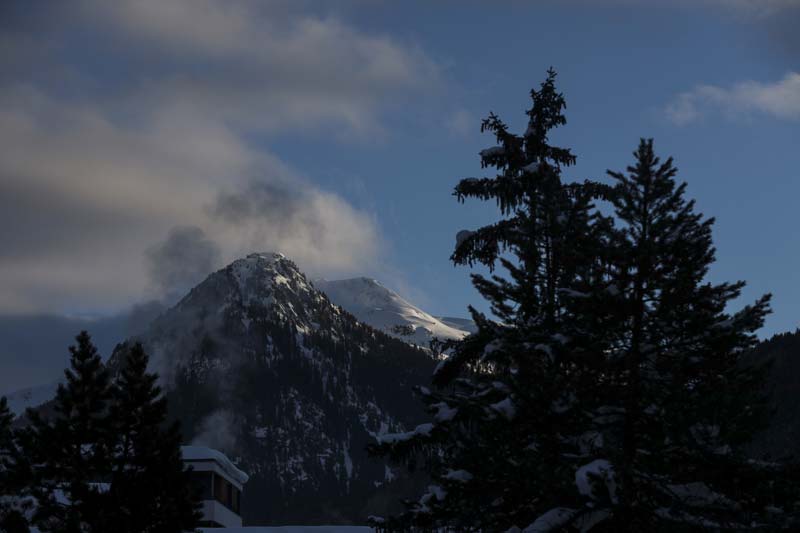 Simon Dawson for Bloomberg
Simon Dawson for Bloomberg
Beginning in the 18th century, Davos and its supposedly healing mountain air drew scores of consumption patients to sanitariums for treatment. Patients ate five meals and guzzled two liters of milk each day, went for walks and sunned themselves on balconies.
"In the early 1920s it was the melting pot of old noble families, the rich upper class, sick dandies and millionaires from all over the old world," said Tobias Engelsing, director of the Rosengarten Museums of Konstanz in Germany.
But, as Engelsing wrote in 2007, things took a darker turn in the 1930s. Germany established a Nazi headquarters in Davos, led by a fanatical follower of Hitler named Wilhelm Gustloff. Gustloff used coercion to convince many newly arrived Germans to become members of the party.
Gustloff was assassinated in 1936 by a Jewish medical student, David Frankfurter. And while Nazi activity in the town died down a bit when the war began and Switzerland declared itself neutral, some of the 1,500 Germans living in the town of 10,000 were probably affiliated with the party, according to Timotheos Nilsson, director of Dokumentationsbibliothek Davos, the town's archival library.
Even so, nestled among the dozens of sanitariums that dotted the town's mountains was Etania, a clinic for ailing Jews that even had its own synagogue and Jewish cemetery. Founded in the early 1920s, the center stayed open through the war years and into the early 2000s.
It's also where my grandparents met. The story of what happened to them is one of love and refuge, a fate not many European Jews experienced during the war.
As my mother tells it, my grandmother was living in Vienna when it became clear in 1938 that the city would soon be unsafe for Jews. She was involved with the Communist Party, which smuggled her and her then-husband into Switzerland. There, she worked in Zurich with other Jewish refugees. Approximately 30,000 Jews passed through Switzerland while the Nazis were in power in Germany.
In Switzerland, my grandmother worked as a seamstress near Zurich. It was there she became ill with consumption and was sent to Etania.
Meanwhile, my grandfather was living in Belgium in 1940 when the Germans invaded. Already sick, he was sent to a sanitarium near Brussels, where doctors told him he had to leave because Germans routinely checked the clinic for Jews. He left and walked all the way to Switzerland, his lungs full of fluid, eventually crossing over the French border around the fall of 1941. In Switzerland, the Jewish community sent him straight to Etania.
The pair met in February 1944 on a bench close to the clinic. My grandmother got a divorce - apparently causing quite the scandal - and the two stayed in Switzerland until 1946, when they settled in Belgium.
The same year they met, Davos was greeted by some new visitors: about 300 officers from the U.S. Army Air Forces who had crash-landed their planes in Switzerland. The additions brought a new air of excitement to the town.
"They were a bunch of young men," Nilsson said. "They misbehaved greatly."
The boisterous pilots were put up in fancy hotels and learned to ski - some broke their legs in the attempt. At one point, two American pilots removed a swastika hanging on the door of the German consulate. As Nilsson tells it, they were celebrated in the streets by the local population, "which was quite clearly pro-American."
The mishmash of identities in Davos - Germans and Americans in uniform, the Jewish patients in Etania smack in the middle - made for a bizarre contrast with the conflict raging across Europe. In fact, Davos' mountains also have a history of drawing clashing figures to its snow-capped peaks. In 1929, Martin Heidegger and Ernst Cassirer, two leading thinkers in Europe, met there for a famous public debate about the urgent philosophical questions of the time.
More recently, the World Economic Forum has brought together climate change deniers and environmental activists, advocates and enemies of globalization, and prominent political foes. One has to wonder whether there's something to that mountain air after all.
Every weekday JewishWorldReview.com publishes what many in the media and Washington consider "must-reading". Sign up for the daily JWR update. It's free. Just click here.
(COMMENT, BELOW)


 Contact The Editor
Contact The Editor
 Articles By This Author
Articles By This Author